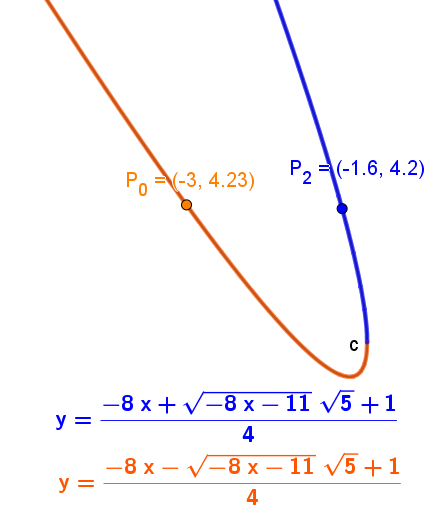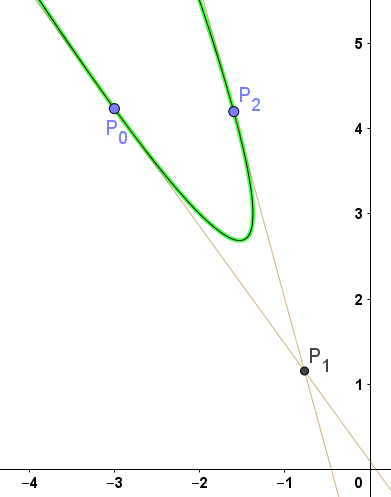Quadratic Bézier
The quadratic Bézier curve is just another quadratic equation and all quadratic equations are parabolas. If it doesn't graph to look like a parabola, then it is because the Bézier is being chopped off and represents only some small segment of the parabola. What we will do in this section is to use the Bézier parametrization to parametrize a specific parabola that has been given as a Cartesian equation. The general procedure is as follows.
- Select two points, $P_{0}$ and $P_{2}$ that are on the parabola. It is OK and perhaps even best if they are on the same side. If they are on opposite sides, then the derivative used to get the slope may change signs since there will be a root in the derivative.
- Solve the parabola equation for $y$.
- Take the derivative, $\frac{dy}{dx}$ of the result in step 2. There will be a $\pm$root and we will have to figure out which one of them to use as our slope.
- Write the tangent line equation at each of the two points.
- Solve for the intersection of the two lines in step 4. Call the intersection $P_{1}$.
- Write an equation like we did for string art.


Vertex of a Bezier Parabola
The parametric parabola is written as $$\left(\begin{array}{c} x\\ y \end{array}\right)=(1-t)^{2}P_{0}+2(1-t)\cdot t\cdot P_{1}+t^{2}P_{2} \tag{6} \label{6}$$ and we can say that the vertex occurs when the magnitude of the derivative is minimized. Any non-colinear choices for the three points will yield a parabola. Let $$P_{0}=\left(\begin{array}{c} x_{0}\\ y_{0} \end{array}\right)\qquad P_{1}=\left(\begin{array}{c} x_{1}\\ y_{1} \end{array}\right)\qquad P_{2}=\left(\begin{array}{c} x_{2}\\ y_{2} \end{array}\right), \tag{7} \label{7}$$ and substitute these points into $\eqref{6}$, expand and take the vector derivatives (both top and bottom). Equation $\eqref{8}$ shows the substitution. $$\left(\begin{array}{c} x\\ y \end{array}\right)=(1-t)^{2}\left(\begin{array}{c} x_{0}\\ y_{0} \end{array}\right)+2(1-t)t\left(\begin{array}{c} x_{1}\\ y_{1} \end{array}\right)+t^{2}\left(\begin{array}{c} x_{2}\\ y_{2} \end{array}\right) \tag{8} \label{8}$$ Equation $\eqref{9}$ is the algebraic expansion into terms $$\left(\begin{array}{c} x\\ y \end{array}\right)=\left(\begin{array}{c} x_{0}\\ y_{0} \end{array}\right)t^{2}-2\left(\begin{array}{c} x_{0}\\ y_{0} \end{array}\right)t+\left(\begin{array}{c} x_{0}\\ y_{0} \end{array}\right)-2\left(\begin{array}{c} x_{1}\\ y_{1} \end{array}\right)t^{2}+2\left(\begin{array}{c} x_{1}\\ y_{1} \end{array}\right)t+t^{2}\left(\begin{array}{c} x_{2}\\ y_{2} \end{array}\right) \tag{9} \label{9}$$ Equation $\eqref{10}$ gets $(dx/dt,dy/dt)$ $$\left(\begin{array}{c} x'\\ y' \end{array}\right)=2t\left(\begin{array}{c} x_{0}\\ y_{0} \end{array}\right)-2\left(\begin{array}{c} x_{0}\\ y_{0} \end{array}\right)-4\left(\begin{array}{c} x_{1}\\ y_{1} \end{array}\right)t+2\left(\begin{array}{c} x_{1}\\ y_{1} \end{array}\right)+2\left(\begin{array}{c} x_{2}\\ y_{2} \end{array}\right)t \tag{10} \label{10}$$ Then collect terms. Notice that there is one term in $t$ and nearly all else are constants. $$\left(\begin{array}{c} x'\\ y' \end{array}\right)=2\left[\left(\begin{array}{c} x_{0}\\ y_{0} \end{array}\right)-2\left(\begin{array}{c} x_{1}\\ y_{1} \end{array}\right)+\left(\begin{array}{c} x_{2}\\ y_{2} \end{array}\right)\right]t+2\left[\left(\begin{array}{c} x_{1}\\ y_{1} \end{array}\right)-\left(\begin{array}{c} x_{0}\\ y_{0} \end{array}\right)\right] \tag{11} \label{11}$$ Equation $\eqref{11}$ is a linear vector equation and just happens to be tangent to our Bézier Curve at any point P(t).
We want to minimize the magnitude of the derivative, so we expect to get something like $$\left(x^{\prime}\right)^{2}+\left(y^{\prime}\right)^{2}=at^{2}+bt+c \tag{12} \label{12}$$ and we already know that the minimum of the parabola $at^{2}+bt+c$ is at the vertex and is given by $$t=-\frac{b}{2a} \tag{13} \label{13}$$ but squaring the top and bottom of $\eqref{11}$ gives a very large number of terms that then must be added together and factored to get $a$ and $b$. There is another way, which is to use a CAS and push in numeric values for the three points thereby getting the coefficients $a$ and $b$ to use in $\eqref{13}$. Also, if you expend the effort to square and add $\eqref{11}$ symbolically, and then you carefully re-assemble the points that we substituted in $\eqref{7}$, you can get the following expression. Note that the dot product causes this to condense to a single value for $t$. $$t=\frac{(P_{0}-P_{1})\cdot(P_{0}+P_{2}-2P_{1})}{(P_{0}+P_{2})\cdot(P_{0}+P_{2})-4P_{1}\cdot(P_{0}+P_{2}-P_{1})}$$ Take this $t$ value and put it into the parametric equation $\eqref{6}$ and the vertex will magically appear. If we do it for the example in figure 2 we get $t=0.54801$ which is used in $\eqref{6}$ to give a vertex, $V=(-1.475,\,2.7)$.
A numeric example of this procedure was given in the section Vertex of a Parametric Parabola.